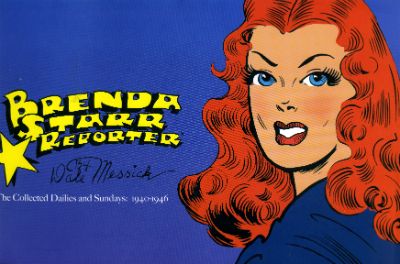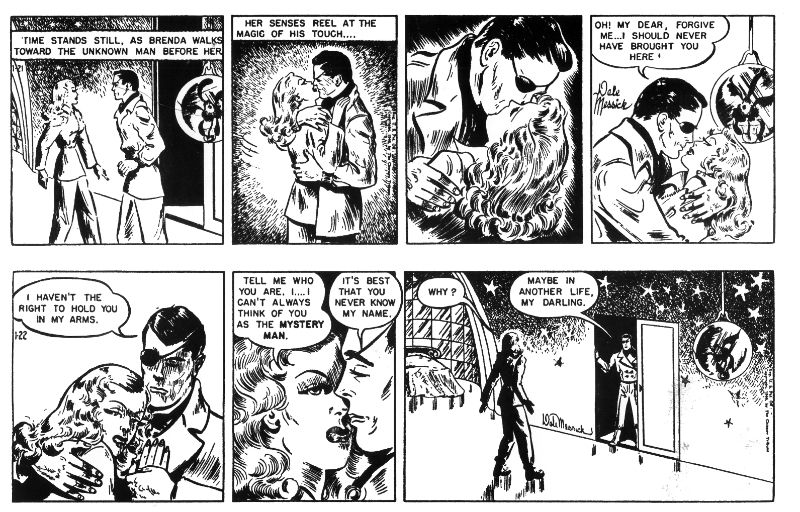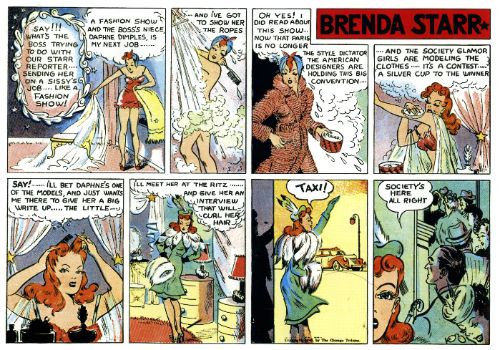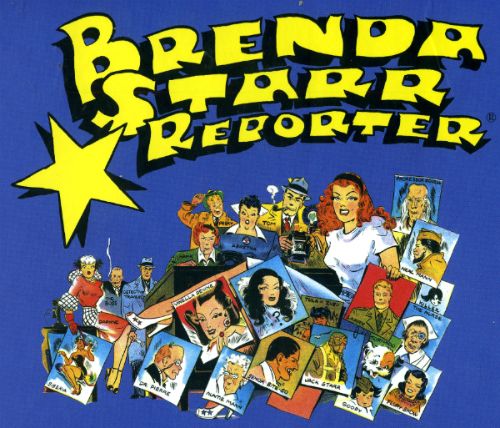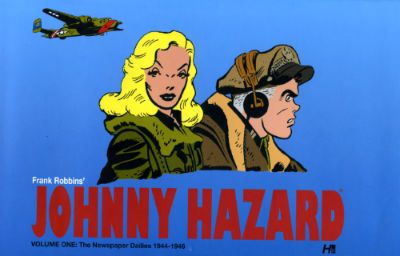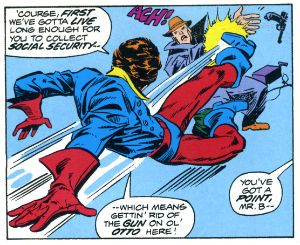"I Wonder If Tom And Larry Would Be So Eager To Marry Me If My...Feet...Were...Gone!" COMICS! Sometimes They Got Moxie, You Betcha!
/As an ancient ladies’ fragrance ad had it, “Men Can’t Help Acting On Impulse”; which is why we have prisons. And, slightly more pertinently, why I bought this book of ye olde newspaper continuities. Repeat offenders will recall that recently I looked at a Hermes Press collection of Frank Robbins’ Johnny Hazard newspaper strips. Hopefully such folk will fail to recall that I was somewhat out of my depth and basically just said "Frank Robbins draws real nice!" in a number of different ways without even a hint of insight. In the uncharacteristically optimistic belief that I could hardly do any worse I thought I’d look at yet more old newspaper strips. This time out they are both about and by a woman. This means there’s every chance I’ll not only fail to say anything of use but I’ll also inadvertently offend fifty percent of the world’s population. Sigh, and this is how I relax; it’s no wonder I have more hair on my toes than on my head.
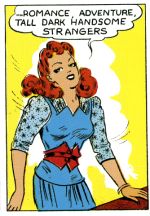
Anyway, this…
BRENDA STARR,REPORTER The Collected Dailies and Sundays: 1940-46 By Dale Messick Hermes Press, $60.00 (2012 Brenda Starr created by Dale Messick Brenda Starr and Brenda Starr, Reporter (c) Tribune Media services, Inc.
One thing that becomes apparent very quickly when you decide to dip a toe in the newspaper continuities pool is the price of the bally things. This one goes for sixty of your Earth dollars. Now, that’s not what I paid thanks to Christmas gift vouchers and a good truffle about for a price within spitting distance of my personal definition of reasonable, but that’s still the RRP. The other thing is such books are pretty niche and people tend to buy them out of a strange kind of forensic curiosity rather than just for pure reading pleasure. What I’m getting at is it’s important to know what you are getting. I was remiss in this area with the Frank Robbins’ Johnny Hazard book which, at this late date, I will inform you contained just the strips but these were crisply reproduced. Which is fair enough; no frills but good stuff. This Brenda Starr book is a bit more of a mixed bag. So, in the interests of people who take their newspaper continuities seriously I will let you know what you are in for if you splash the cash in Brenda Starr’s direction. Some of the reproduction is a bit iffy in this volume so tread wisely.
Foreword by Starr Rohrman Introduction by Richard Pietryzk An Appreciation by Trina Robbins Chapter 1: Beginning Sunday strips from June 30, 1940 through to April 20, 1941. Presented in colour and half a strip to a page. The reproduction is excellent and the reading a pleasure. Chapter 2: The Curious Tale of Mary Elizabeth Beastly Sunday strips from September 10, 1944 through to January 14, 1945. Presented in crisp and clear B&W. With one exception these are taken directly from the original artwork. Chapter 3: The Man of Mystery Sunday and daily strips from October 22,1945 through to February 24,1946. The reproduction on the colour sundays remains good but the B&W dailies are a bit lacking. Process A brief and basic look at process but with some nice original art and colour guide stuff. Afterword by Laura Rohrman
And now I start flapping my jaw…
Dalia (“Dale”) Messick was born in South Bend, Indiana on April 11th 1906 and in 1940 she created the newspaper strip Brenda Starr for the Chicago Tribune. She created the strip under the less gender specific moniker of Dale as, back then, women weren’t taken too seriously in the comic strip biz and men’s hands had a tendency to wander. My, how things have changed, he said tonelessly. Now I’m going to make a half-hearted stab at showing a modicum of interest in the human being who made these strips. Don’t worry it’s not much; just other people’s words rewritten enough to avoid legal action (hopefully), but it’s better than nothing. Call me Icarus.
So, in between 1906 and 1940 what was Dalia Messick up to? That’s 34 years in there, that’s not chump change time-wise. Well, Dalia Messick spent the first part of her life as a child attending Hobart High School where her reported severe myopia, poor spelling and left handedness indicate those were not the happiest days of her life. Maybe, as it is for many such children, art was a refuge; maybe it wasn’t, but art was where Dalia Messick ended up and judging by how she got there it wasn’t by chance. Usually around this point I’d be obliged to point to the fact that her mother was a milliner and her father was a sign painter hence her budding artistic interest and later commercial success.
That’s a bit pat, maybe? Well, I do think the milliner thing is interesting because Messick’s art very much resembles the fashion illustrations of the time; full of sweeping lines and curves. Her strips have a marked emphasis on apparel rather than the folk sporting it. And hats; Brenda Starr is all about the hats. There’s even an innovative “soil hat” to keep the flowers adorning it fresh; it didn’t catch on. Milliners (like her Mum; keep up) design and manufacture hats, so I’m not just grabbing this stuff out of thin air. Mind you, I’m not sure about the sign painting her Dad did though. I guess it could have set in place the importance of bold visual appeal in snaring attention; something these strips also trade in. While Messick’s strips lack Milton Caniff’s (or Frank Robbin’s Caniff informed) chiaroscuro approach or Alex Raymond’s mannered elegance they do have energy. Sure, Brenda Starr is scruffy stuff in comparison to Terry and the Pirates or Flash Gordon, but what its visual raggedness lacks in precision it makes up for with impact and the eye really tears through this stuff. I’ve just exhausted all my points of ye olde newspaper strip reference, but I imagine quite a lot of the strips of the time got by on, er, enthusiasm rather than majestically realised technique. I doubt though that many strips of the time cherished fashion as much as Brenda Starr did.
Brenda Starr is a romantic adventure strip so, sure, there are cars and building and desks and snow and rocks and all that scenery malarkey but it’s all a poor second to the fashion stuff. Yes, there’s scads of high adventure and derring-do in Brenda Starr; there are parties, mysterious millionaires, marriage proposals, young men cross dressing in sea shell brassieres, eye patched lotharios and all the enchantingly surreal stuff you’d expect from such a papery cough-syrup daydream, but there’s also a whole lot of vogueing going on. As the cupid struck men around Brenda prove it’s not unusual to fall in love with anyone, and nor is it unusual for the bulk of a Brenda Starr strip to consist entirely of Brenda flouncing around in a ridiculous concoction of feathers, fur and lace. Sometimes her kit is so flamboyantly bizarre that she resembles nothing less than a haute couture version of the Animal-Vegetable-Mineral Man. I say her outfits are ludicrous creations but I am pretty much fashion unconscious so I could be wrong there. They are certainly, um, distinctive, as they say in Paree. Yes, distinctive indeed as are each of the strips no matter the schmutter Brenda’s bedecked in. I won’t lie; these strips are kind of clumsily garish and oddly distorted and, at first, I didn’t know what to make of them. And that’s why I read up about her and did a bit of poking about at 1940s stuff. Hence the enormously speculative bit about how her Mum and dad, and their jobs, fed into her art. Even better and, better still, even less speculative is the fact that Messick worked in the greeting card industry before her strip was picked up by the Chicago Tribune. Because if there’s one thing these strips resemble it’s 1940s greeting cards pressed into service as a narrative.
Reading other people’s research tells me that Messick spent the tail end of her 34 years prior to hitting the comics jackpot in the greeting card industry. She must have had a knack for it because she managed to support her family through the Great depression with such work. I guess people may not have wanted hats designing or signs painting but they still wanted to send chirpy bits of card to each other; go figure. By 1940 America had been hoisted up out of the Depression by its bootstraps via the brawny Liberalism of Roosevelt’s New Deal and, of slightly less historical import, Dale Messick’s art was forever imprinted by her past vocation. Who would have guessed a bunch of newspaper strips about a flighty but capable and independent female reporter in impractical clothing would weather the years better than Liberalism. Now, as awesome as the days when Liberals got shit done were (so awesome; so, so awesome), things weren’t all rosy back then, no, what with all that sordid kerfuffle over in Europe and all that sexism in the men everywhere. Oddly, Brenda Starr, on the admittedly incomplete evidence of these strips, largely ignores the whole unfortunate Second World War thing preferring instead to accentuate the positive and carry blithely on as though nothing is happening. Plenty of other people picked up the slack on that, but few strips would have reflected so well the growing emancipation of the women on the Home Front.
And Brenda Starr does it naturally without polemic or stridency simply by being a strip about a woman with moxie. Brenda may not appear terribly self-determining and there appears to be a total lack on Messick’s part to be pushing any agenda as such, but by simply being what it is it is of significance. If I, somewhat unscientifically, take some lady-centric comics I’ve been looking at lately we have Brenda’s near contemporary, and Ms Messick’s namesake, Dale Arden; there she is dressed for a bordello and endangered approximately every seventeen and a half minutes on an alien planet, and she’s mostly concerned with getting Flash Gordon to marry her. Then there’s Diana Prince: Wonder Woman from the progressive year of 1968 in which Steve Trevor picks up a strange hippy woman in a bar and Diana Prince just weeps unsettlingly fat white tears while upbraiding herself not to be so jealous. Back in this century I’ve read a couple of 2013 comics which are, you know, just the same old violent boys comics but the hero is a heroine with a name like Silky Fontaine. Which is fine if you like that; fill your boots. But I’ve met a couple of women over the last four plus decades and I can exclusively reveal to you now that some women like romance, some women have even been known to take an interest in fashion, and, it beggars belief this, they are capable human beings who get stuff done. Now, I don’t want to end up refusing to leave the house until sufficient people sign a petition saying I’m not a monster but perhaps, just perhaps, there might be a very profitable middle ground in comics between portraying women as sex toys or sad death machines.
Dalia Messick wrote and drew Brenda Starr from 1940 to 1980 and it continued in other hands until 2011. That’s not small potatoes there and it’s probably largely down to the fact that her audience could identify with Brenda and live vicariously through her. As gaudy as her adventures may have been Brenda was always just a woman. While there’s no end of everyman characters in comics there’s a real dearth of everywoman characters. And there is an everywoman; ask Chaka Khan. Brenda Starr might appear unfashionably feminine but she is who she is and she’s happy being like that and it holds her back not a jot. I enjoyed Brenda Starr because Brenda Starr reminded me very much of the last five minutes of INLAND EMPIRE; an eruption of women being unapologetically happy in themselves. How could that ever be less than GOOD!
It's A Fair Cop, Guv Dept. John got any facts in the above from the wikipedia page abour Dale Messick. There are a lot more facts on there and also some useful links at the bottom of the page.


